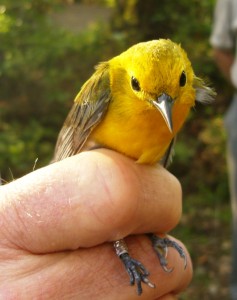
I am holding a life in my hands. It consists of less than half an ounce of feathers, one fast-beating heart, and not much else.
This tiny gal — the plumage says it’s a female — has just flown over the open waters of the Gulf of Mexico, a solid 100 hours without stopping to eat, rest or drink. She’s used every milligram of fat her little body ever had, she hasn’t seen land for days, and practically the first thing she did was run into a bander’s net. It hardly seems fair.
She’ll soon be released, though.
In Your Bucket Because…
- You will learn things about birds you never could have imagined.
- You’ll get to witness one of the worlds great bird migrations.
- Good for: Nature lovers, bird watchers, and families.
First, this scrawny Prothonotary warbler must be weighed (four-tenths of an ounce), and measured (O percent body fat), and banded with a metal bracelet about the size of a grain of rice.
And, second, if there are visitors about, one of the volunteers at this bird-banding station, located across from Fort Morgan in Gulf Shores, Alabama, will gently hold the bird by slipping its legs between their fingers. Hoping to keep the world safe for birds a little longer, they will talk about migration and conservation. And maybe, just maybe, they will convey something of the miracle they feel each time they pick up and band one of the billions — yes, billions — of tiny songbirds that migrate across the Gulf of Mexico each year.
A Passion for Birds
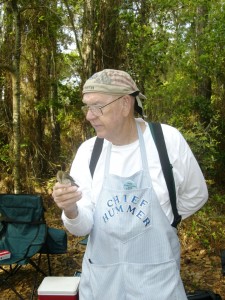
Birds are the passion of Bob and Martha Sargent of Clay, Alabama, founders of The Hummer/Bird Study Group (HBSG), a non-profit organization dedicated to the study and preservation of hummingbirds and neo-tropical migrating songbirds. The Sargents run the bird banding program here on Alabamas’s Gulf of Mexico coast, where they collect data from thousands of birds during each year’s migration.
Retired electricians, the couple spends three or fourth months a year following the annual migrations, traveling to southern Alabama, then Texas and beyond. In early April each year, they come to Gulf Shores, Alabama, to band birds completing the annual northbound crossing of the Gulf of Mexico. Today, they’ve been here since an hour before sunrise, banding birds caught in nets strewn through the maritime forests near Fort Morgan on the western tip of Gulf Shores.
“Between me and you,” Bob tells me, “What we do is fun. It’s not hard to get up before dawn everyday. This is my favorite place on earth.”
And indeed, Bob has the look of a man who is right where he ought to be. He’s been coming here for 20 years, he says, launching into a description of the maritime forest habitat and the beaches, of historic Fort Morgan just across the road, of the nearby Bon Secours National Wildlife Refuge, which is prime habitat for shorebirds, and of the scores of species of birds (179 were counted as of that morning) that pass through here each year.
The Bird Banding Stations
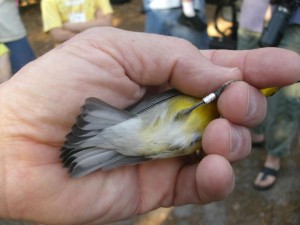
One of the naturalists is walking down the trail, carrying a netted bag. He hands it to Bob, who gently removes the bird, cupping it in his hand. He quickly examines the bird and calls out numbers: weight, body fat, species, sex — information that will be relayed to the Bird Banding Laboratory at the USGS Patuxent Wildlife Research Center in Laurel, Maryland.
Then, so deftly that I barely see what he’s doing, he fits a tiny piece of metal around the bird’s leg and records the nine-digit number printed on it. Months or years later, this bird might be found, who knows, on the slopes of the Andes or the tundra of the Russian Arctic, or anywhere in between. Data collected here and there will tell ornithologists about migration and breeding patterns, and give information about habitat. But fewer than one percent of banded birds are ever reported; those that are found are usually casualties of collisions with windows.
Once the measurements are complete, Bob hands the bird off to naturalist Scott Weidensaul, a 2000 Pulitzer prize finalist for his book Living on the Wind: Across the Hemisphere with Migratory Birds (North Point, 1999). Quietly, a group gathers around: Small children, grandparents, casual tourists who stumbled across the sign and wandered in to see what’s up. The naturalist has their undivided attention.
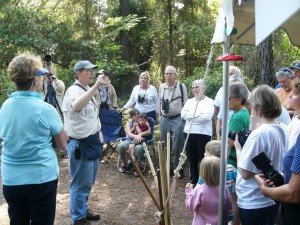
Listening to Scott speak, you can’t help but be entranced by his passion: The sheer wonder of a tiny songbird that has the audacity to fly for hundreds of miles over open sea, the miracle of a trans-continental journey completed one wing beat at a time. You can see the amazement in the children’s eyes: They stare at the tiny bird as though it were a TV celebrity. And then Scott talks about threats: Not just distance and exhaustion and no food for days, but habitat destruction, which means no safe place to rest, feed, or breed at the journey’s end. Rainforest destruction in South America, shopping malls in Ohio: Nowhere is immune.
Coffee to the Rescue!
You can see the audience take in the scope of the problem. You can see them wonder. How can a person living in the middle of Ohio or on the coast of New Jersey possibly make a difference in the life of a tiny bird flying across the Gulf of Mexico?
“Easy,” Scott tells them. “Buy good coffee.” Everyone perks up: We all drink coffee, especially this early in the morning.
“Switch to shade-grown,” he tells us.
Actually, it’s just a bit more complicated than that, as there are various designations of eco-friendly coffee: shade grown, bird-friendly, organic, fair-trade. Shade-grown can mean a thriving multi-story rainforest flush with native plants and plenty of healthy habitat for pest-eating birds. Or it can mean a scruffy monoculture shaded by only the occasional planted palm tree. As always, the big corporations are prowling around the edges of the definitions, trying to get some of that good green marketing luster to rub off on their bottom line by calling things “green” when they might more accurately be called an unhealthy shade of puke. Coffees bearing the “Bird Friendly” certification created by the Smithsonian Migratory Bird Center (SMBC) are grown sustainably, in ways intended to preserve habitat — and provide a healthier, chemical-free brew. Scott recommends a company called “Birds and Beans.”
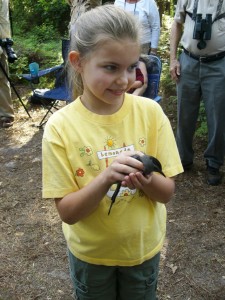
It’s time to let the bird go, and Scott asks for volunteers from the audience. Usually, there’s an eager child who steps forth, but this time the kids are shy, most of them hiding behind a parent’s leg. So it’s my turn. Scott gently hands me the bird. I loosely cup one hand over it. I feel its heart beat, its weightlessness.
I open my hands and the bird flies free. My eyes follow it until it disappears, bound for who-knows-where: the Midwest, perhaps, or northern Canada, or even the vast frozen expanse of Siberia.
And as the bird disappears, I hear Bob Sargent’s words, spoken earlier that day: “We don’t live in this world alone. These birds have the absolute right to be here; they have a value of their own. We have to speak for them.”
Practicalities
- The bird-banding station operates each year at Fort Morgan in early and mid-April (roadside signs direct visitors to parking). The Sargents arrive about a half an hour before dawn, hoping to catch some nightbirds to add to the tally; they close shop at around 3 in the afternoon. You can show up anytime during the day to see what’s going on. Early morning is the best time.
- Children are welcome.
- There is no charge, but books are for sale, and donations are gratefully accepted.
- Bring bug spray.
- If you aren’t in Orange Beach/Gulf Shores in April, try to schedule a visit in early October for the Alabama Coastal Bird Fest, which occurs annually during the fall migration. Participants can learn about birding, banding, migrations, and environmental issues affecting migratory birds. Or visit the nearby Bon Secours National Wildlife Refuge, which has walking trails and outlooks.
Links updated January, 2021.
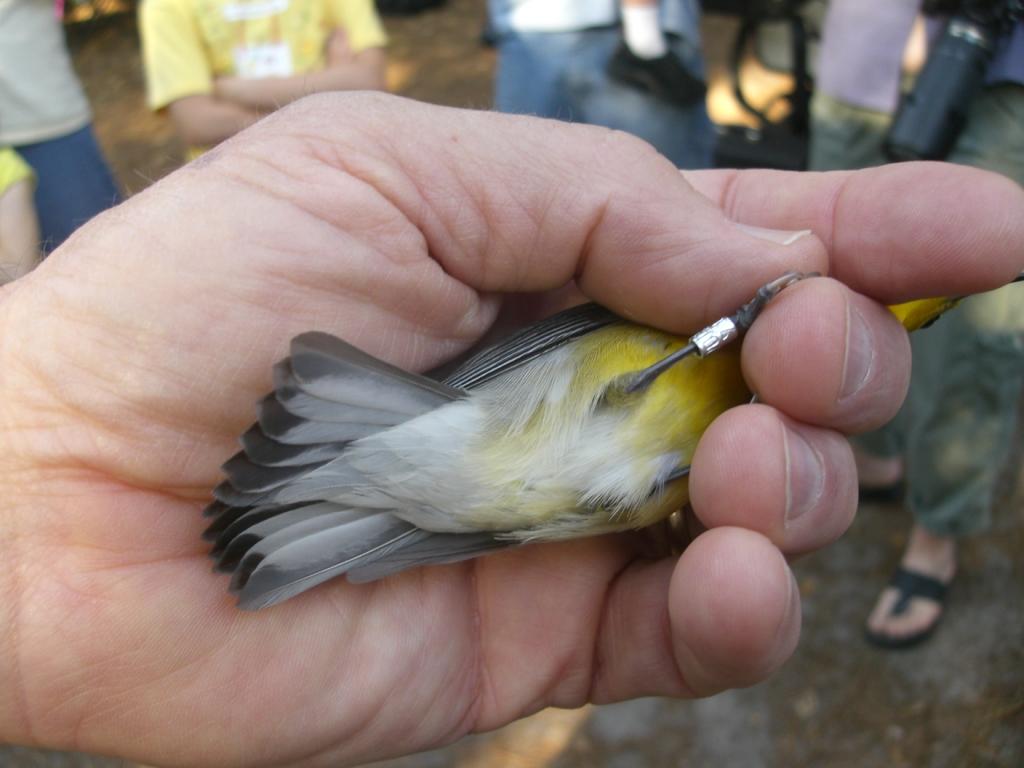


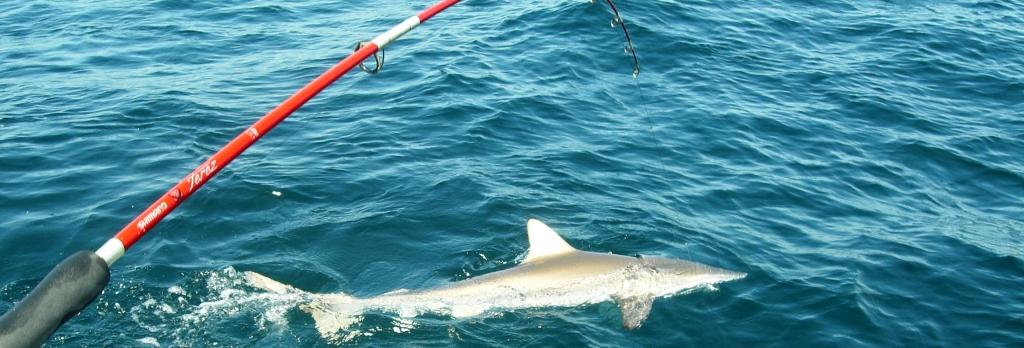
Proud to report, that I was one of the lucky bird watchers, to hold , and release a Ruby throat hummingbird . One thrill of a lifetime !!!
How lucky for you! It is almost hummingbird season where I live — three to four weeks away — and we will have our feeders out by May 1.
Was at the bird banding last year.As a snowbird from Canada this experience was the highlight of my 6 month stay in Alabama.